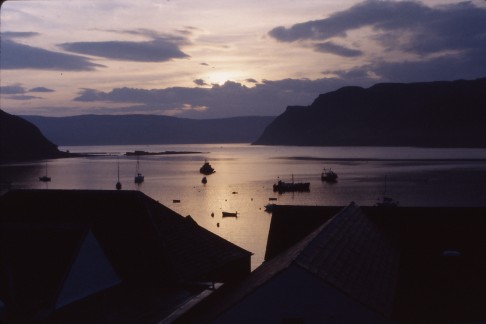
1. Sunrise over Portree Harbor. The larger boats in the distance are fishing trawlers; the smaller ones are a couple of pleasure craft and some outboard motorboats.
Day 2 started in Portree. I was awake about 7AM, but we weren't due to leave until 9:30. So I filled the time with a walk around Portree's central area, from the hotel down to the harbor which is just a couple of blocks away. The harbor is home to a half dozen or so fishing boats and some pleasure craft, mostly motorboats but a few sailboats too. There are a lot of sailboats in Scotland, on the lochs and the coastal waters. Sunrise over the harbor was awesome, so much so that I went back to the hotel, got my camera, and shot about a dozen pictures from various places & angles.
When the camera shop opened I went in there and bought three extra rolls of film, so that problem was taken care of. That's another interesting thing: nearly the entire town opens at 9 and closes at 5:30. Period. Nothing stays open later except the hotel, restaurants, and a couple of small stores.
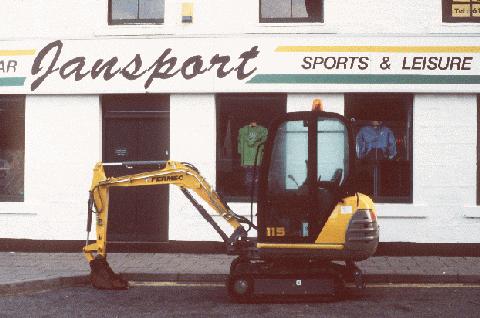
2. The miniature power shovel, sitting in front of an ordinary storefront.
While waiting for the bus, just for the heck of it I took a picture of a power shovel that was sitting on the street waiting for its operator to come get it and take it to work. They'd been doing some sort of work on a street, maybe pipe repair, and needed the shovel to dig it up. In all the time I was there, I didn't see anything that did a better job of illustrating the difference between Scotland and the US. When you see a power shovel working on a US city street, odds are that it's pretty big, with an arm eight or ten feet high and a shovel that's three or four feet across and can move cubic yards of earth at once. But in Portree, and most of the other Scottish towns we saw, the streets are so narrow that a machine that large won't fit. So they use machines like this. If not for the normal size operator's cab, you might have thought it was a toy.
(I should add that in the years since I went to Scotland, I've seen more and more of these mini-sized power shovels on American roads. Were they always around here in the States and I just never noticed them? Or did American construction companies borrow the idea from the Scots?)
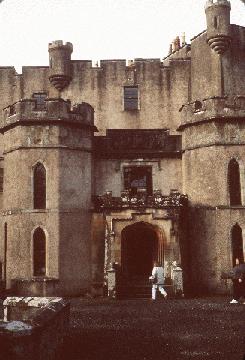
3. The entrance to Dunvegan Castle. While it's been made to look pretty for tourists like us, under the veneer Dunvegan is still a formidable fortress.
From Portree we headed round the northern part of the island to Dunvegan Castle, hereditary stronghold of Clan Macleod. The castle is fairly large as such things go, both a military fortress and a living center. It's been modified and enlarged many times over the years. The interior hallways are full of relics and portraits of past Macleods (interestingly, one of the clan-chiefs was a woman), and the rooms open to tourists include some truly amazing woodwork and silverwork. Intricately carved cabinets and bookcases; beautifully cast silver dishes and candleholders; I wish I could have gotten some pictures, but no pictures are allowed inside the castle. The best I could do was a few pictures from the outside.
There was a dungeon, of course, with an especially cruel twist: the structure of the castle put it not far from the kitchen, and some past Macleod chief had an air vent put in the dungeon so that the wretches confined there could smell the food being prepared for the chief's dinner.
There was, as there always is, a souvenir shop. While I dislike the general tackiness of most souvenirs and souvenir shops, I did buy a couple of small books about Dunvegan, and also a Macleod-crest keychain.
Modern world intrusion: Several times while we were there, jet aircraft passed overhead at very low altitude and high speed. When I got back outside, I saw one of the jets. It was an RAF Tornado fighter-bomber. At the time I thought they were on training flights from the RAF base at Stornoway, but I later learned that RAF Stornoway officially closed down in March 1998. So that guess was wrong, and I have no idea where they were flying from.
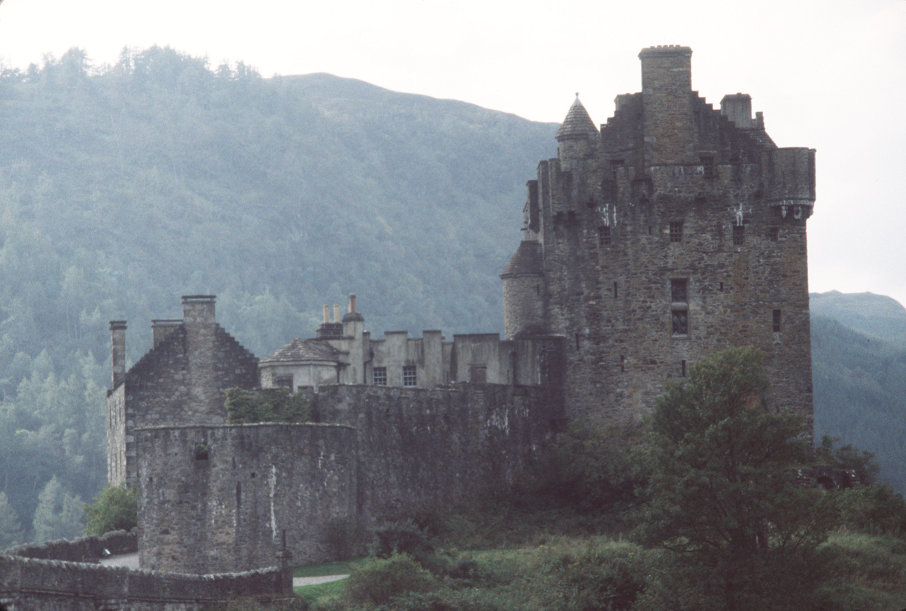
4. Eilean Donan Castle. This is an early twentieth century restoration of a castle that was last occupied in the early 1700s. It was destroyed by English ships in 1719, after the Jacobite Rising of 1715.
From Dunvegan we headed south and east again, across the bridge at Kyleakin back to the mainland. (Along that road we got our only live look at Highlander cows, which look like very shaggy Texas longhorns.) Our next stop was Eilean Donan, a fully restored 1700s castle which is the one seen in the movie Highlander. Eilean Donan is said to be the most photographed castle in Scotland, and for good reason: while it was obviously placed for military benefit, it's also a quite beautiful setting, and very picturesque.
Actually, "Eilean Donan" is the name of the island. The castle is "Eilean Donan castle." Eilean Donan is a tidal island: at high tide it's a true island surrounded by several feet of water, but as the tide falls the water recedes and the castle becomes accessible across an expanse of mudflats. It's such a perfect place for a fortress that there has been some sort of fort on the island since at least the early 13th century.
From Eilean Donan we headed east along the A87 to Invermoriston, which is about two-thirds of the way down Loch Ness's 25-mile length. Then we headed up Loch Ness to Inverness. Unfortunately, it was early afternoon by this time, so we didn't have time to stop at Urquhart Castle. Not much to see on the loch either -- the wind was kicking up, and the water was so rough there were some small whitecaps on it. We stopped at the Monster Centre in Drumnadrochit, then headed on to Inverness, where we stopped at a large store called James Pringle Weaving before going on to our hotels. This store sells an amazing collection of clothes woven from Highland sheep wool, as well as a wide variety of music, knickknacks, and gewgaws. I don't know what other people bought; I bought a book about Nessie, a couple of music tapes, and a woolen throw-rug woven in the Macleod tartan pattern. I spent about forty pounds; I have a strong suspicion that others in our group spent a LOT more. :-)
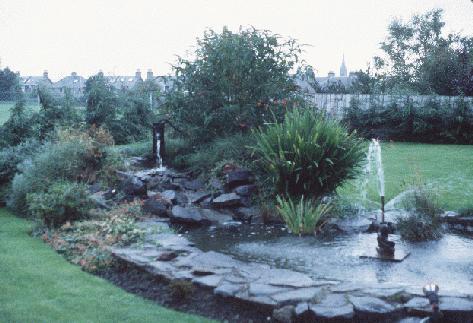
5. In Scotland, even the backyard gardens are genuinely pretty. This is the backyard garden of Alban House, the bed-and-breakfast I stayed in the night we were in Inverness.
Our hotels in Inverness were in a classic Scottish type of lodging: a bed and breakfast (B&B). Actually, three B&B's -- a typical B&B is a converted house, and no way can one of them hold twenty-two people. You get a room with a breakfast included -- hot if you want it, continental if not. These three B&B's where we stayed were very nice; by an interesting coincidence, all the beds had Macleod tartan blankets, and the lampshades were also Macleod tartan patterns.